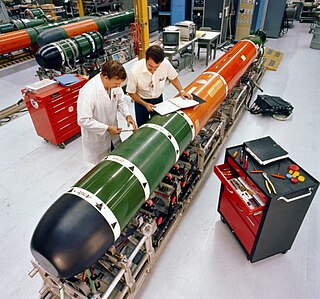| Mark 33 torpedo | |
|---|---|
| Type | Acoustic torpedo [1] |
| Place of origin | United States |
| Service history | |
| In service | never in service |
| Production history | |
| Designer | Bureau of Ordnance [1] General Electric Exide |
| Designed | 1943 [1] |
| No. built | 30 [1] |
| Specifications | |
| Weight | 1795 pounds [1] |
| Length | 156 inches [1] |
| Diameter | 21 inches [1] |
| Effective firing range | 5000-19,000 yards [1] |
| Warhead | HBX [1] |
| Warhead weight | 500 pounds [1] |
| Engine | Electric [1] |
| Speed | 12.5-18.5 knots [1] |
Guidance system | Gyroscope [1] |
Launch platform | Submarines and aircraft [1] |
The Mark 33 torpedo was the first passive acoustic antisurface ship/antisubmarine homing torpedo intended for the United States Navy to employ a cast aluminum shell. It featured two speeds – high and low, and was meant to be launched from submarines and aircraft. [1]

An acoustic torpedo is a torpedo that aims itself by listening for characteristic sounds of its target or by searching for it using sonar. Acoustic torpedoes are usually designed for medium-range use, and often fired from a submarine.

The United States Navy (USN) is the naval warfare service branch of the United States Armed Forces and one of the seven uniformed services of the United States. It is the largest and most capable navy in the world and it has been estimated that in terms of tonnage of its active battle fleet alone, it is larger than the next 13 navies combined, which includes 11 U.S. allies or partner nations. with the highest combined battle fleet tonnage and the world's largest aircraft carrier fleet, with eleven in service, and two new carriers under construction. With 319,421 personnel on active duty and 99,616 in the Ready Reserve, the Navy is the third largest of the service branches. It has 282 deployable combat vessels and more than 3,700 operational aircraft as of March 2018, making it the second-largest air force in the world, after the United States Air Force.

Casting is a manufacturing process in which a liquid material is usually poured into a mold, which contains a hollow cavity of the desired shape, and then allowed to solidify. The solidified part is also known as a casting, which is ejected or broken out of the mold to complete the process. Casting materials are usually metals or various time setting materials that cure after mixing two or more components together; examples are epoxy, concrete, plaster and clay. Casting is most often used for making complex shapes that would be otherwise difficult or uneconomical to make by other methods.
Production of the Mark 33 was discontinued at the end of World War II, but its features were incorporated into the Mark 35 torpedo.

World War II, also known as the Second World War, was a global war that lasted from 1939 to 1945. The vast majority of the world's countries—including all the great powers—eventually formed two opposing military alliances: the Allies and the Axis. A state of total war emerged, directly involving more than 100 million people from over 30 countries. The major participants threw their entire economic, industrial, and scientific capabilities behind the war effort, blurring the distinction between civilian and military resources. World War II was the deadliest conflict in human history, marked by 50 to 85 million fatalities, most of whom were civilians in the Soviet Union and China. It included massacres, the genocide of the Holocaust, strategic bombing, premeditated death from starvation and disease, and the only use of nuclear weapons in war.
The Mark 35 torpedo was the first of the United States Navy deep-diving anti-submarine torpedoes designed for surface launch. This electrically propelled 21-inch (53-cm) torpedo was 162 inches long, weighed 1770 lb (803 kg), and carried a 270 lb (122.5 kg) Torpex high explosive warhead. This torpedo used one of the earliest active guidance systems and was introduced in 1949, but was classified as obsolete in the 1960s.















